Java Fern are beloved aquatic plants cherished by aquarium enthusiasts worldwide for its unique appearance and ease of care. In this comprehensive guide, we will delve into the step-by-step process of growing, caring for, and propagating Java Fern in your aquarium.
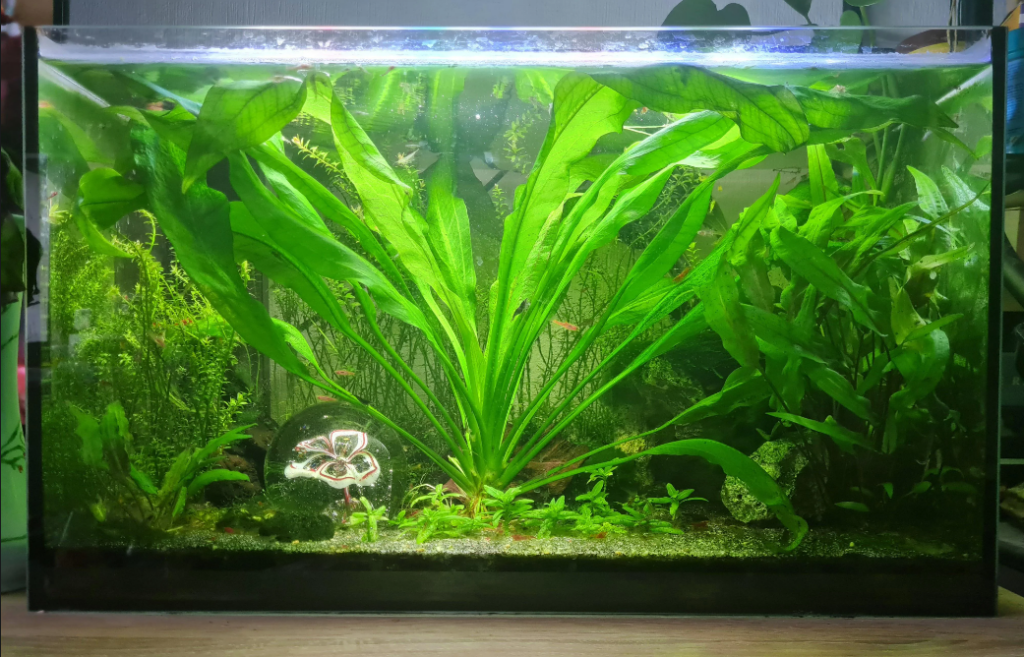
Java Fern (Microsorum pteropus) is, perhaps, the hardiest aquatic plant out there and besides its rather unusual ways of propagation, there are only a handful of peculiarities you’ll need to know before getting one yourself.
Caring for this plant and growing it is easy once you have taken the time to master its relatively simple requirements.
It is one of those plants that are always determined to survive no matter what you put on their path.
There are some essentials on how to correctly approach the planting process in order to achieve successful and continuous growth though.
Once you get this done correctly you will not have to buy another Java Fern plant again, because they will easily reproduce.
This guide will teach you how to care for the different types of Java Fern plants even as an absolute beginner.
But right before we start, I’d like to show you how a healthy Java Fern in a planted fish tank looks like:

Photo By jaheu
Java Fern Plant Rundown & Origins
| Scientific Name | Microsorum pteropus |
| Common Name | Java Fern |
| Origin | South East Asia |
| Light Requirements | Low to moderate light |
| Size | 6 to 14 inches |
| CO2 Requirements | Not Needed |
| Growth Rate | Slow |
| Tank placement | Foreground, midground, or attached to driftwood or rocks |
The Java Fern plant is scientifically known as Microsorum pteropus and is a native of South East Asia, specifically Malaysia, Thailand, and some areas of China. It belongs to the Polypodiaceae family and is identified by distinctive green, leathery leaves that resemble fern fronds.
There are more than 50 known varieties of Java Fern plants with a couple of them being really popular in the aquarium hobby for their ease of care and hardiness.
Regardless of the species, Java Fern’s maximum height is generally about 13 to 14 inches in a fish tank setting and slightly past this in the wild. Its height makes it a background plant suitable for many aquarium setups. It’s better to position the plant near the back wall of the aquarium because if you place it in the front, its leaves will eventually block your view.
Although its growth rate is low to moderate in a home aquarium setting, it is recommended you keep Java Fern in at least a 10-gallon tank to create enough surface area for oxygen absorption.
The Java Fern’s roots are dark brown, thin, and hairy, resembling a brush.
These roots will always be growing until they find a surface to tangle around.
They are designed to cling and attach themselves to surfaces as opposed to absorbing and transporting nutrients, as usually is the case with other plant roots.

By phyzzix
The role of absorbing and storing nutrients is for its rhizome, the fleshy part at the base of the plant. The Rhizome of a Java Fern is thick and stem-like but it grows horizontally, unlike the typical stems.
The moment the roots have established themselves around an object and the anchorage is dependable, the rhizome of the plant then grows until it covers the object.
The leaves of Microsorum Pteropus are dark green but their shape and size depend on the origin or on each specific variety.
For instance, a particular plant variety may have twisted, forked, narrow, or broad leaves.
Here are the common Java Fern variety types:
- The Windelov Java Fern
- The Narrow Leaf Java Fern
- The Lance Leaf (or regular) Java Fern
- The Needle Leaf
- Trident Java Fern
- Latifolia Java Fern
- Petite Java Fern
Note that Java Fern will not only survive but actually do well in brackish aquariums.
In the wild, the plant mostly grows in wetland areas around the coastal rivers of West Peninsular Malaysia. The salinity in these rivers varies between 0 and 34.7 ppt (parts per thousand) which equals up to 1.0256 SG (specific gravity).
Typically, Brackish water is categorized as any water with a salinity of between 0.3 to 25 ppt. The salty water is present in the region where the river meets the ocean, which is up to 12 km or 7.5 miles away from the coast.
This means that the Java Fern plant can naturally adapt to survive these conditions and is a good fit for aquariums with brackish water.
Aquanswers Suggests: List of Aquarium Fish for Brackish Aquariums
Here’s a photograph of a dense Java Fern growth from West Peninsular Malaysia:

By Fhurzan
How to Take Care of Your Java Fern?
That said, let’s dig deep into the level of care that a Java Fern would require to thrive instead of just survive.
The Java Fern plant is easy to care for and is not going to demand special requirements in your planted tank.
Here’s how to look after your Java Fern plants:
1. How to Plant it Properly?
As I explained, the Java Fern uses its brushy roots mainly to get a foothold or anchorage, not for food absorption.
If you bury its rhizome in the aquarium substrate, the roots are going to rot which can destroy your Java Fern all the way up.
When growing Java Fern, simply attach it to an aquarium rock, driftwood, or some stable decorations using super glue or fishing line.
Anyway here is a step-by-step guide on how to plant Java Fern:
- Select an object for weight.
Find an object like driftwood, rock, shell, or any other aquarium décor but make sure whatever you go for is rough-surfaced so it can provide the roots of the plant with attachments.
Smooth surfaces can also do but it will take a longer time for the roots of the Java Fern to pick up.
Whatever object you choose should be able to remain immobile if you do not want to see your Java Fern floating all over the place.
The object should weigh the plant down, that is.
- Tie the roots to the object.
You then tie the roots of the plant to the object so that they don’t float away in the water.
Many people tend to use black tapes, fishing lines, strings, or threads to tie the roots since the roots themselves are near-black and so the tie wouldn’t be visible.
But that’s a matter of style — you can use whatever you have at hand to tie down your Java Fern, be it a rubber band or zip ties. You can also stick the plant’s roots together using aquarium-safe super glue.
Alternatively, instead of tying the roots, you can tie your Java Fern’s rhizome to the object.
The roots of the plant will still take hold of the object.
- Remove the ties after a couple of weeks.
After a couple of weeks, the roots of your Java Fern will have attached themselves firmly to the object so you can remove the ties.
However, this is optional. If the ties are not visible and your new plant holds well, there may be no need to remove them.
Your Java Fern will start growing and taking off, once it has adjusted to your aquarium’s water conditions.
2. Reproduction and Propagation Techniques for Java Fern
If there’s one thing Java Fern is good at, it’s effortless reproduction.
While it involves no flowers or seeds, the unconventional Java Fern reproduction still has the potential to eventually fill up a planted aquarium if not controlled.
The asexual propagation of Java Fern is also an effortless task and there are 2 main mechanisms the plant uses. If you sense the plant has reproduced more than necessary, you can transfer the surplus reproduction to another tank, fill other parts of the same tank or gift them to fellow aquarists.
The following 2 methods should guide you on how to propagate a Java Fern plant:
- Cut a piece of Rhizome and anchor it elsewhere.
This method of plant propagation is also known as the rhizome division.The Java Fern rhizomes are the powerhouse of this plant.
The rhizome nutritionally supports the roots and the leaves of the plant.
This is how to go about the rhizomes propagation:
Using scissors, cut a piece of the parent Java Fern rhizome and attach it to another driftwood or another suitable object you have.
This is how propagating from the leaves of Java Fern is achieved:
On the edges or undersides of the Java Fern leaves are spores that develop into small plantlets after about three weeks.
Said spores appear as circular black or brown spots that are almost symmetrically situated across the leaf’s length.
The plantlets eventually grow roots to start a new Java Fern plant.
If left to follow the natural order of events, the plantlets eventually fall away to create their own niches.
You simply pluck these plantlets off the leaves when they are about 2 inches long and plant them elsewhere.
This is known as leaf propagation in Java Fern.
If you find plucking to be tedious, use a pair of stainless steel scissors to cut them off.
Leaf propagation in Java Fern happens naturally and if you want to achieve thick dense vegetation you can leave the plant to its natural course of reproduction.
3. Suitable Water Parameters & Tank Size for Java Fern
Java fern is a tropical, freshwater plant but, interestingly, it can tolerate (slightly) salty or brackish water. The plant usually thrives best in temperatures ranging from 70 to 75°F (21 – 24°C). However, Java Fern will also survive in temperatures as high as 85°F (29.5°C) or as low as 14°C which is roughly 57°F.
That’s just how hardy the Java Fern plants are because their natural habitat has forced them to become highly adaptive.
It’s worth pointing out that keeping it on the softer side of the spectrum will produce the best results in terms of growth.
Java Fern doesn’t require much CO2 but it needs plenty of oxygen in the water, which is quite the opposite of what many aquarium plants need.
When considering the addition of a Java Fern in your tank, ensure that you provide plenty of space for its growth. A minimum tank capacity of 10 gallons (38 liters) is suggested for accommodating Java Fern alongside other aquatic life. Larger tanks offer ample space for the plant to grow and avoid overcrowding, which can hinder its growth and overall health.
4. What Are the Light Requirements for a Java Fern?
Java Fern is a highly resilient plant that can survive a wide range of lighting conditions.
However, in the wild it’s typically found in shady areas near waterfalls or streams.
These conditions lead to the slow growth and deep green color Java Ferns are famous for.
And even though increasing the amount of light accelerates their growth, you can easily burn their leaves if you’re not careful.
So with that said, here’s how much light a Java Fern needs:
Java Fern has low to medium lighting requirements which means that it can be successfully kept under a weak LED fixture. Using bright aquarium lights isn’t recommended since it can melt the leaves of the plant.
I’ve listed some of the best LED lights for all kinds of planted aquariums, including ones with low light plants, in my guide which you can find here. If the lighting intensity is too high, the scorched leaves of the plant may turn brown and start falling.
If you have to use high lighting for the benefit of other tank inhabitants, then ensure your Java Fern is at least in a shaded section away from the direct light. A good idea for such a setup is a planted tank that’s partially covered with floating aquarium plants.
The floating plants will help with thinning the intense light.
5. Using an Aquarium Plant Fertilizer for HealthyGrowth
Java Fern is rather hardy, but common logic says that every aquarium plant should benefit from a certain dose of additional nutrients.
That being said, does the resilient Java Fern need fertilizer to help with growth?
Java Fern can still thrive without aquarium plant fertilizers so it is not necessary to add any. The plant grows slowly so it can do with the little nutrients it gets in the aquarium. These nutrients are usually produced by fish or introduced via tap water when performing tank maintenance.
However, if you are impatient with the slow growth of your Java Fern, you may have to use a plant fertilizer to boost its performance or vibrancy.
If you are going to use an aquarium fertilizer, ensure it is a liquid one since Java Fern absorbs nutrients via the leaves, so the plant food should be in the water column, not the substrate.
So what should you go for if you feel your Java Fern needs an aquarium plant fertilizer?
In my experience and observation, Java Fern tends to grow faster and puts on lushly, dense leaves when you dose the planted aquarium with a Phosphate fertilizer.
So if you have to choose, go that direction as long as the level of Phosphate in the aquarium’s water is not already high.
A good all-in-one fertilizer for undemanding aquarium plants would be the Seachem Flourish Comprehensive. It only provides micronutrients, which is ideal for hardy aquarium plants such as Java Fern.
Such aquarium plants already are really good at getting their macronutrients from their environment. If you’d like to see my personal experience with this fertilizer you can visit my guide on foods for aquarium plants.
6. Trimming Methods
While Java Fern requires little to no maintenance, once in a while you will notice that a leaf has turned brown or developed scorched spots.
Old plant leaves also eventually die off, in keeping with the natural order.
The plant could also be sprouting more leaves than a fish tank can accommodate.
The bottom line is: you have to trim the unwanted leaves of Java Fern once in a while.
So this is how to trim your Java Fern:
To trim an overgrowing Java Fern you should cut the excess or dying plant leaves as close to the rhizome as possible, leaving no leaf stump hanging. You then dispose of the trims. A new plant leaf will sprout from the old spot soon enough.
Plant Health and Well-being of the Java Fern
For your fish or aquarium plants to stay continuously healthy, there are steps you have to always take.
Here I want to focus on the measures ensuring that your hardy Java Fern plant enjoys being in your aquarium.
As you are going to find out, some steps are crucial and should not be ignored, while others are mere misconceptions.
Circular Black to Brown Spots That Form on the Plant Leaves of Java Ferns
There is one misconception when it comes to the circular black or brown spots that form on the plant leaves of Java Fern.
Some aquarists see them and conclude that the Java Fern is sickly or something else is wrong with it.
This is, however, a common misconception that needs to be addressed.
Here is what you should know about black to brown circular spots forming on Java Fern leaves:
The raised black or brown spots with a circular shape are just the points where the new Java Fern plantlets are going to emerge from. The spots are actually sporangia – tiny pods of plant spores. Java Fern never bears seeds; instead, new Java Fern plantlets sprout from these black spots on the undersides of the plant’s leaves.
In short, black or dark brown spots are a sign the Java Fern is expecting.
Don’t assume every black spot on your Java Fern is a plant sprout.
An easy way to tell is if the spots have formed in an almost symmetrical pattern along the length of the plant leaf.
They will also appear raised.
Here’s a visual example of how the black spots, which are actually sporangia, look like when a Java Fern plant is about to reproduce:

By landsy32
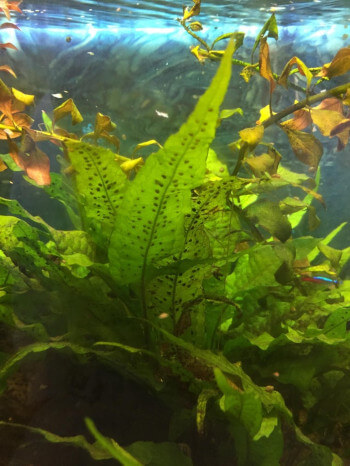
By hollisrobbie
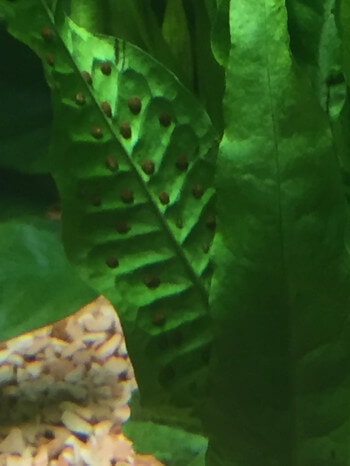
By calamityclifford
Is Very Slow or Absent Growth a Problem?
Java Fern is by nature a slow-growing plant.
This is one of the reasons it is suitable for low-maintenance aquariums, which are often chosen by beginners.
The last thing you need in a small aquarium is a weed-like plant that overgrows at short notice.
Therefore, slow growth should not alarm you.
A Java Fern plant that’s not growing (even by its own standard) could be the result of over-exposure to excess light.
Conversely, the lack of sufficient light could also lead to stunted growth.
And even though it requires less light, you should still let your Java Fern have some so it doesn’t wither away. A well-thought balancing act is key.
Another case of stunted growth in Java Fern could be during the first couple of weeks after the plant’s introduction to the aquarium.
Java Fern plants need some time to adjust their nutritional intake, along with establishing anchorage and a healthy root system.
These processes happen simultaneously during the first 15 to 25 days after the plant has been introduced to its new aquarium setting.
Java Fern Leaf Matter Turning Black and Melting Away
From what I have experienced, there is no single cause behind the Java Fern leaf melt.
So what happens here is that the Java Fern leaf or leaves develop large black patches, and then, rot.
The leaves of the aquarium plant finally fall or melt away.
It could be that Java Fern is lacking in some vital nutrients.
If leaf melting occurs soon after you’ve introduced a Java Fern into your fish tank, it could be that the plant is yet to adjust to the water parameters. This mostly affects older leaves that have matured under different conditions. The old plant leaves of Java Fern will naturally wilt, giving way to new more environmentally-adapted ones.
That being said, excess light can also lead to Java Fern leaves gradually turning black so ensure that you do not “high-light” your planted aquarium.
Black aquarium algae could initially form as spots, which will later develop into hair-like growth. You should also remember that at some point old plant leaves have to die a natural death and blackening is also their process of dying off.
The good news, in this case, is that the dying Java Fern leaves usually sprout new healthier plantlets to take over before they ultimately burn out.
Can You Get a Lush Java Fern Specimen Online?
My experience has been that you can safely purchase a Java Fern plant online, as long as you know who to turn to. I have more than once bought aquarium plants online because I enjoy the comfort of shopping from my couch.
It helps to carry out precautionary, background checks anytime you buy anything online, not just aquarium plants.
Like, is the business well-reputed? What do reviewers say about those aquarium plants? Who and who has bought from them? How long has the seller been in this line of business?
I can spare you a couple of hours of background research and point you to a Java Fern seller on Amazon that I trust. Here is one dependable merchant I have engaged with whenever I need a Java Fern plant.
The aquarium plant comes in a pot and usually the shipping is free. In the link, I’ve chosen the exact plant species, but you can browse around and see if anything else seems fit for your planted aquarium.
Tankmates for java fern:
As mentioned Java Fern are pretty hardy plants so they do not have much problems when it comes to most fish that you house in a tank that has Java Fern.
Here are some examples of compatible tank mates for Java Ferns:
- Neon Tetras
- Corydoras Catfish
- Otocinclus Catfish
- Betta Fish
- Harlequin Rasboras
- Dwarf Gouramis.
- Ghost Shrimp
- Mystery Snails
- Celestial Pearl Danios
However, species such as African Lake Cichlids and Crayfish may not be compatible with Java Fern as they might harm the plant.
My Final Words
As always, it’s my high expectation that you have found relevant or valuable help to whichever concern you had about looking after your new Java Fern.
Armed with these care tips, go ahead, and introduce the new plant to your aquarium.
Drop me a comment to share your thoughts.


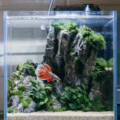
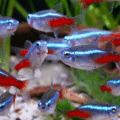

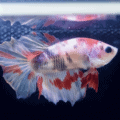
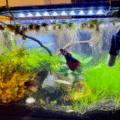
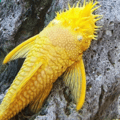



3 thoughts on “The Complete Guide to Java Fern: Growing, Caring, and Propagation in Your Aquarium”